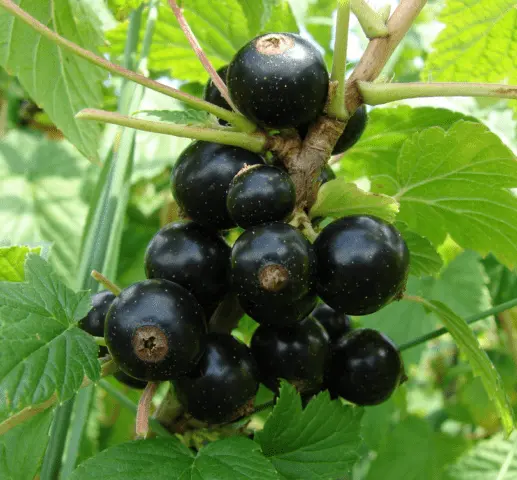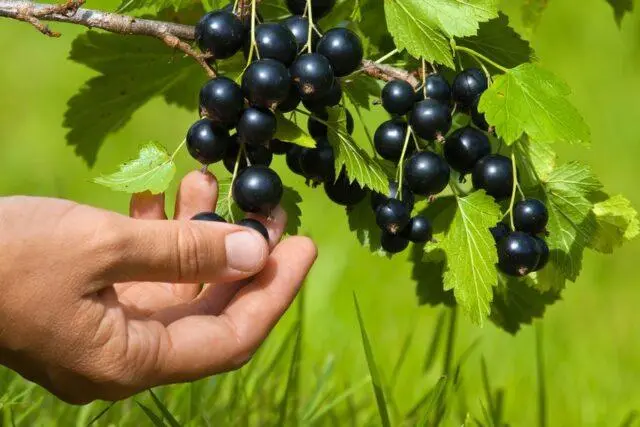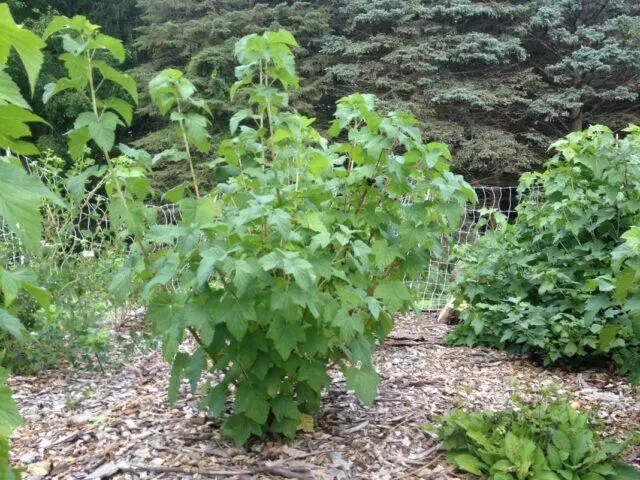Contents
Currant Little Prince – a variety of selection. Differs in very tasty berries, gives a stable harvest not less than 4 kg from a bush. Agrotechnics of cultivation is simple, while the culture is winter-hardy. You can breed it in most regions of the country.
History of breeding
Currant Little Prince – a variety of selection, bred on the basis of VNIIS them. I.V. Michurin. Received by breeders T.V. Zhidekhina and T.S. Zvyagina. The varieties Black Pearl and Ojebin are taken as the basis. The culture was successfully tested, and in 2004 it was included in the register of breeding achievements.
The variety is approved for cultivation in different regions of Central Our Country:
- middle lane;
- Chernozem region;
- Northwest.
Description of the blackcurrant variety Little Prince
Currant bush The Little Prince is medium-sized, moderately sprawling. Shoots are straight, rather thick, can be bent. Young branches are green, adults are woody. They are greyish in color with a yellowish tint. In this case, the tops are brown, may have a golden hue.
The kidneys are small, ovoid, located singly, sessile. Slightly pressed against the shoot, have a light brown color. The leaf scar has a round-wedge shape.
Currant leaves Little Prince of the usual five-lobed shape, medium size, typical green color. In the sun they shine weakly, have a smooth surface. The blades are pointed, while the lateral ones are widely spaced. Leaf plate with fine teeth, petioles are small, of moderate thickness, have a reddish-violet color.
Currant flowers Little Prince is goblet-shaped, with reddish free sepals that bend back in an arc. The brushes are small (length from 4,5 to 6,2 cm), cylindrical in shape. They have a straight axis of medium size and a short petiole.
The berries are medium and large in size, weight is from 1,5 to 1,8 g. The shape is typical round, the color is black, a slight sheen is noticeable. The fruits are nonuniform. There are not very many seeds in the berries of the currant Little Prince. The pulp is juicy, has a pleasant sweet and sour taste. At the tasting, the variety received a high rating – 4,6 points out of 5.
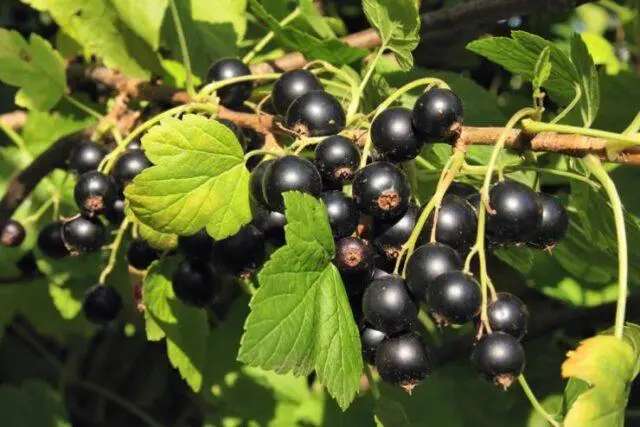
Currant berries Little Prince ripen at the end of June
According to the results of the analysis, the following chemical composition of the fruit was established:
- dry matter – 19%;
- sugar (total) – 10,7%;
- acids – 2,6%;
- vitamin S – 140 mg per 100 g;
- P-active components – 800 mg per 100 g;
- pectin – 2,6%.
Features
Currant The Little Prince tolerates frost well in a temperate climate zone. The culture has sufficient immunity to various diseases and pests, which allows you to get a stable harvest.
Drought resistance, winter hardiness
Currant Little Prince has a fairly good winter hardiness. During the tests, the bushes did not freeze slightly. Therefore, culture can be bred not only in the tolerance regions, but also in the Volga region, in the regions of the Southern Urals and Siberia.
The drought resistance of the variety is low. In the heat, the bushes need additional weekly watering. Otherwise, the berries will shrink, which will adversely affect the yield.
Pollination, flowering period and ripening period
The currant variety Little Prince is self-fertile, so the plants do not need to be adjacent to other varieties or attract pollinators. Flowers appear already in the second half of May, the total flowering period lasts until the first decade of June inclusive. Ripening dates from the end of June to the second half of July. According to this indicator, the Little Prince is an early and early-growing variety.
Productivity and fruiting, keeping quality of berries
The yield of the Little Prince currant is satisfactory – it is possible to collect 4,1 kg of berries from one bush. In industrial cultivation, the indicator is 13,6 t/ha. Fruiting begins at the end of June, the main period falls on July. In general, the harvest can be harvested in 5-8 days.
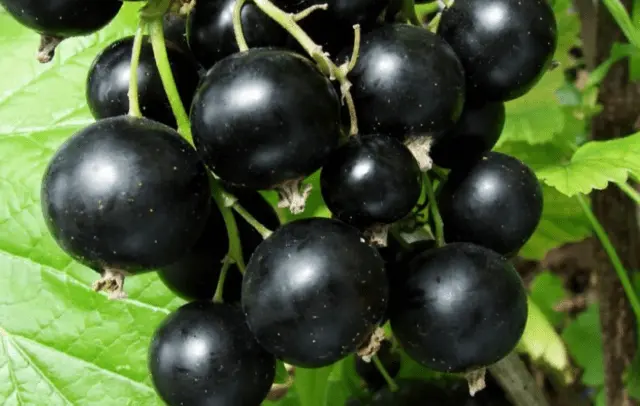
The yield of the Little Prince variety is up to 4,5 kg per bush
The fruits are distinguished by good keeping quality. In the refrigerator, cellar and other cool rooms, they can be stored for 15-20 days. Transportability is also quite high – the berries endure transportation within 5-7 days.
Disease and pest resistance
The little prince is resistant to common diseases – powdery mildew, leaf spot. However, it can suffer from other fungal infections, as well as from aphids, leaf sawflies, bud mites and other pests.
Therefore, it is recommended to carry out preventive treatments with fungicides every year. The best period is early spring (late March – early April). First, the Little Prince currant bushes are treated with boiling water, after which they are sprayed with a solution of Bordeaux liquid. Instead, you can use other means: “Maxim”, “HOM”, “Fundazol”, “Skor”, “Ordan”.
The Little Prince fights insects on currant bushes with folk remedies (a solution of ash with soap, tobacco dust, an infusion of onion peel, garlic cloves, mustard powder) or special insecticides: Biotlin, Vertimek, Aktara, Confidor, ” Decis” and others.
When using chemicals, harvesting can begin after 3-5 days.
Advantages and disadvantages
The little prince is valued by summer residents by farmers for good taste, stable harvest and the possibility of growing on an industrial scale. The variety also has other advantages.
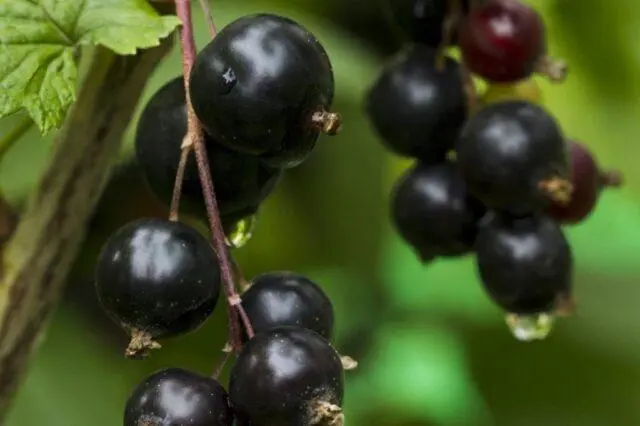
Currant berries Little Prince juicy and sweet
Pros:
- good taste;
- precociousness;
- self-fertility;
- keeping quality and transportability;
- winter hardiness;
- resistance to many diseases;
- can be harvested mechanically;
- satisfactory yield.
Cons:
- not drought resistant;
- not resistant to kidney tick;
- The berries fall off rather quickly.
Features of planting and care
Currant seedlings The Little Prince is purchased from nurseries or trusted suppliers. Planting material must be completely healthy, preferably with a closed root system. Planting is planned for autumn (from late September to the first decade of October) or mid-April.
The place for the currant Little Prince should be sunny, dry (not a lowland) and protected from the wind (next to the fence, buildings). The site is prepared in a few months – it needs to be cleaned, dug up and brought in a bucket of organic matter (compost, humus) per square meter. If the soil is clayey, 1 kg of sawdust or sand is embedded in it per 1–2 m2.
The algorithm for planting currants Little Prince is standard:
- Dig several holes at a distance of 1-1,5 m from each other. Their depth should be small – 40 cm, diameter – 50 cm.
- If the soil was not previously fertilized, mix the surface layer of soil with compost (8 kg), superphosphate (8 tablespoons) and wood ash (3 tablespoons).
- Currant seedlings The Little Prince is soaked for several hours in a mixture of water, earth and “Kornevin” or another growth stimulant.
- Planted at a right angle.
- They tamp a little so that the root neck goes to a depth of 5–7 cm.
- Abundantly watered. Use 2 liters of settled water per bush.
- Mulch for the winter with peat, sawdust, straw, dry foliage.
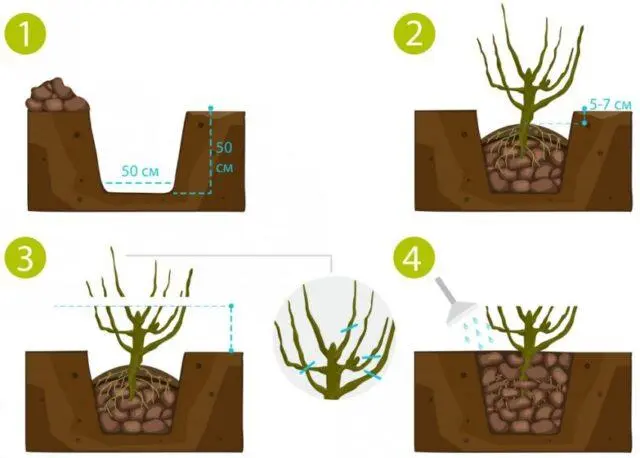
Only if the planting algorithm is followed will it be possible to get good bushes
In the description of the variety and the reviews of summer residents, it is said that in order to grow currants, the Little Prince (pictured), you must adhere to several rules:
- Water young seedlings weekly.

Adult plants are given water 1-2 times a month, and in case of drought – every week
- Feed currant bushes begin from the second year. In mid-April, urea is given (15–20 g per plant), in May – organics (mullein, chicken manure), in August – potassium salt (20 g) and superphosphate (40 g).
- The soil is periodically loosened (especially after watering and heavy rain), weeding is done. To keep weeds from growing as little as possible, it is also recommended to lay mulch during the warm period.
- In late March and early October, pruning is done annually. Remove all weakened, frost-bitten branches. They form the crown of the bush, regularly remove old shoots (age 5 years or more).
- In all regions, except for the southern ones, the Little Prince currant bushes are recommended to cover for the winter. At the end of October, they are carefully bent to the ground and pinned with staples. Spruce branches or agrofibre are laid on top. Shelter will allow you to survive even Siberian frosts
Conclusion
Currant Little Prince has a number of advantages. This is a crop with a simple cultivation technique. Therefore, both an experienced and a novice summer resident will be able to shoot a stable crop. The berries are quite large, with a pleasant sweetness. Suitable for fresh consumption and for all kinds of preparations.
Reviews with photos about the currant variety Little Prince
